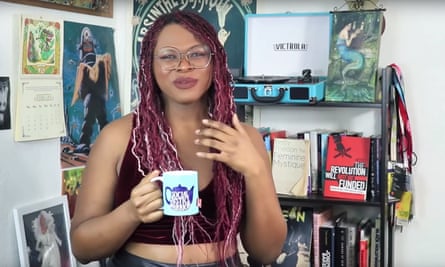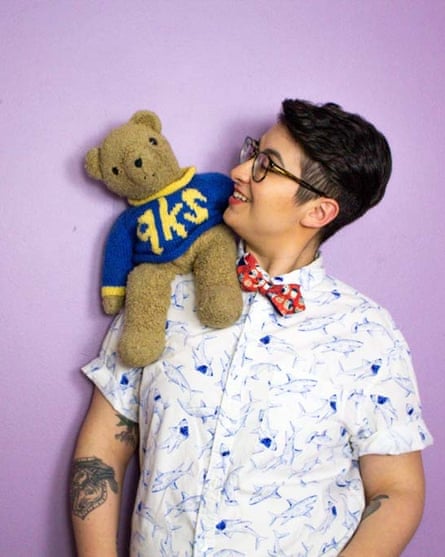YouTube’s haphazard response to an anti-gay harassment controversy this week underscores the company’s continuing failure to protect creators from hate speech, queer users say.
The platform’s initial refusal to discipline Steven Crowder for years of sustained anti-gay and racist harassment of Carlos Maza, a video journalist for the US news site Vox, drew widespread criticism.
The company’s response was “not surprising”, said Ash Hardell, a queer and non-binary YouTuber who said they had received little support from the company despite years of harassment. Watching YouTube send a series of conflicting messages regarding abuse from its official Twitter account, which is sporting a rainbow-emblazoned logo for Pride month, only added to the frustration.
“It feels like a slap in the face when they use queer content in their promotional videos,” they said. “It feels like exploitation – if you want to use us, you actually have to care about us.”
Hardell posts LGBTQ educational and entertainment content, with videos like “I Dyed My Armpits Rainbow ... ’cause Gay” and “Hilarious Prank on my Wife”. They have intimately documented their coming out process and top surgery procedure, sharing confessional videos with hundreds of thousands of followers.
They have also had content censored and comments disabled due to problems with YouTube’s algorithm. In 2018, also during Pride month, YouTube was criticized after anti-LGBTQ ads were run alongside content made by queer creators.
This week’s controversy began when Maza made a video outlining the years of abuse he has endured from the rightwing video personality Steven Crowder. YouTube said Crowder’s attacks on Maza calling him a “gay Mexican”, a “lispy queer” and a “token Vox gay atheist sprite” did not violate its community guidelines against harassment.
After criticism, YouTube announced it would be re-evaluating harassment policies and update them “in coming months”. Google employees under the group moniker Googlers Against Hate called on the company, which is owned by Google, to remove its rainbow branding until it changed its policies.
Kat Blaque, a YouTuber and trans rights activist, said YouTube’s revenue model inherently incentivized volatile behavior. Blaque has made videos about “why liberals annoy me”, defining anarchy, and topics related to dating, weight loss, and beauty.
“When YouTube allowed monetization for all creators, it empowered a group of people to create content, not because they were passionate about it, but because it made them a lot of money,” Blaque said. “With that, you have people who inevitably find out that being mean to other people is lucrative.”
Demonetizing hateful content is a step in the right direction, but the company’s refusal to remove Crowder’s account suggests he is “the kind of creator YouTube wants”, Blaque said.

YouTube’s unclear terms of service make addressing harassment confusing and difficult, Hardell said, noting that the company appeared to have made them intentionally vague. As of now, YouTube bans “abusive videos and comments” on the site but doesn’t clarify what constitutes abuse.
“If harassment crosses the line into a malicious attack it can be reported and may be removed,” the guidelines say. “In other cases, users may be mildly annoying or petty and should be ignored.”
Hardell said because of this wording, it was difficult to tell if Crowder’s videos violated YouTube’s harassment policy. Indeed, YouTube itself seems to be unclear on whether the speech is allowed on the platform.
“One particular challenge we face more and more these days is creator-on-creator harassment,” a YouTube spokesman, Chris Dale, said in the company’s post on Wednesday. “Even if a creator’s content doesn’t violate our community guidelines, we will take a look at the broader context and impact, and if their behavior is egregious and harms the broader community, we may take action.”
As the target of a number of harassment campaigns, Hardell has not known where to turn in the past for help, relying on messaging YouTube’s account on Twitter or publicly complaining, as Maza did.
“It’s not clear what to do – it’s a crapshoot every time,” Hardell said. “Right now it feels like the only way to get help is to have a large following and make a big stink about it, which does not set a good relationship for YouTube and its creators.”
Demonetizing users can sometimes backfire: as YouTube has attempted to tamp down on “inappropriate” content, whether adult videos, hate speech, or harassment, some LGBTQ creators have been misclassified. Hardell said their videos were deemed “adult content” by the same algorithms meant to protect them, bringing viewership and ad revenue down.
Other queer creators have also been affected: comedian Gaby Dunn said her LGBTQ content had been flagged as “not suitable for all advertisers” and the transgender vlogger Erin Armstrong said she watched her revenue plummet after advertising was removed from her videos.

Lindz Amer, a creator of social justice videos on YouTube who is queer and non-binary, said this kind of harassment had been an issue since YouTube’s inception, and that despite a series of high-profile hate campaigns in recent years, “nothing has been done”.
“The thing that is most striking about it is that this is a story I have heard from so many people – it’s not a unique situation in any way,” they said. “This is pretty much the norm for social justice creators.”
Despite these frustrations, switching platforms is not an option for many creators. Amer said they had received more than 2m views on their channel, with an average of 100,000 views per video on YouTube. When they tried to migrate content to Vimeo, they got an average of five views per video.
“YouTube has a complete monopoly on video hosting, and they know it,” Amer said. “There is no other place like YouTube to get an audience where people can watch for free. They have that advantage and they can steer the conversation and do nothing.”
